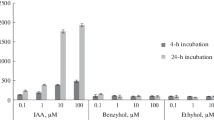Summary
An analysis of the IAA/Tannin-Antagonism which occurs in oat-coleoptiles was carried out. The investigations were done with 10 mm coleoptile sections of 4-day-old seedlings of Avena sativa L. var. “Flämingsgold”.
First it was shown that the IAA/Tannin-antagonism which could be established with a tannin-preparation by “Fluka” resembled very much that caused by “Merck-Tannin”. Whereas the antagonism which was demonstrated by “Merck-Tannin” seemed to be independent of the IAA concentration, the antagonism induced by “Fluka-Tannin”, showed a strict correlation to the applied amount of IAA. An increase of the IAA concentration resulted in a decrease of the antagonistic tannin effect. A 5·10-5 molar tannin solution reduced the activity of an IAA-oxydase preparation by 71–92%.
Oat-coleoptile cylinders which were preincubated for 4 hours in a 10-5 molar or a 10-4 molar IAA solution and subsequently treated with tannin for 16 hours showed no growth inhibition at all.
After a preincubation period with tannin solutions (5·10-6 up to 5·10-4 M) for 3 hours the uptake of IAA during 20 hours by oat-coleoptile cylinders was lowered by 12–45%. It seems to be clear that the IAA/Tannin-antagonism in buffered solutions is due to a remarkable drop in the IAA uptake by the coleoptile tissue.
Zusammenfassung
-
1.
In der vorliegenden Arbeit wurde eine Analyse des IES/Tannin-Antagonismus bei Haferkoleoptilen versucht. Die Untersuchungen hierzu wurden mit 10 mm langen Haferkoleoptilcylindern 4 Tage alter Keimlinge von Avena sativa L. var. „Flämingsgold” durchgeführt.
-
2.
Zunächst konnte gezeigt werden, daß verdünnte, wäßrige Lösungen eines Tanninpräparates von „Fluka” ebenso wie die eines früher verwendeten Präparates von „Merck” einen IES/Tannin-Antagonismus hervorrufen. Im Gegensatz zum „Merck-Tannin” nahm jedoch bei Verwendung von „Fluka-Tannin” der IES/Tannin-Antagonismus mit steigender IES-Konzentration ab.
-
3.
Tannin in einer Konzentration von 5·10-5 M reduziert die Aktivität eines IES-Oxydasenpräparates um ∼80%.
-
4.
Haferkoleoptilcylinder, die 4 Std lang in IES-Lösungen (10-5 bis 5·10-4 M) vorinkubiert waren, zeigten nach einer anschließenden 16stündigen Tanninbehandlung im Vergleich zu den Kontrollpflanzen keinen signifikanten Unterschied im Längenzuwachs.
-
5.
Die IES-Aufnahme von Koleoptilcylindern, die 3Std in Tanninlösungen (5·10-6 bis 5·10-4 M) vorbehandelt waren, wurde innerhalb von 20 Std um 12–45% herabgesetzt.
-
6.
Die Versuche machen deutlich, daß der in Lösung beobachtete IES/Tannin-Antagonismus auf eine Permeabilitätsveränderung der Zelle zurückzuführen ist, die sich in einer verminderten IES-Aufnahme durch das Gewebe bemerkbar macht.
Similar content being viewed by others
Literatur
Brown, B. R., and S. M. Bocks: Some new enzymic reactions of phenols. Enzyme chemistry of phenolic compounds, ed. by Pridham, p. 129–138. Oxford, London, New York, Paris: Pergamon Press 1962.
Endres, H.: Die Gerowirkung niedermolekularer Polyhydroxyphenole. Leder 12, 294–297 (1961).
— P. Stadler u. A. A. cel Sissi: Zum Mechanismus der Gerbung. III. Mitt. Die Gerbwirkung verschiedener p-Chinone. Leder 15, 102–109 (1964).
Gordon, S. A., and R. P. Weber: Colorimetric estimation of indoleacetic acid. Plant Physiol. 26, 192–195 (1951).
Grassmann, W.: Moderne Theorien über den Mechanismus des Gerbvorganges. Vortr. Bad Dürkheim 1960.
Henderson, J. H. M., and J. P. Nitsch: Effect of certain phenolic acids on the elongation of avena first internodes in the presence of auxins and tryptophan. Nature (Lond.) 195, 780–782 (1962).
Höfler, K.: Permeabilität und Plasmabau. Ber. dtsch. bot. Ges. 72, 236–245 (1959).
—: Grundplasma und Plasmalemma. Ihre Rolle beim Permeationsvorgang. Ber. dtsch. bot. Ges. 74, 233–242 (1961).
Leopold, A. C., and H. Plummer: Auxin-phenol-complexes. Plant Physiol. 36, 589–591 (1961).
Nitsch, J. P.: Methods for the investigation of natural auxins and growth inhibitors. Chemistry and mode of action of plant growth substances, ed. by Wain and Wightman. London: Butterworth Scientific Publication 1956.
—, et C. Nitsch: Composes phenoliques et croissance vegetale. Ann. Physiol. végét. 4, 211–225 (1962).
Platt, R. S., and K. V. Thimann: Interference in Salkowski assay of indoleacetic acid. Seience 123, 105–106 (1956).
Rabin, R. S., and R. M. Klein: Chlorogenic acid as a competetive inhibitor of indoleacetic acid oxidase. Arch. Biochem. 70, 11–15 (1957).
Sonderheimer, E., and D. H. Griffin: Activation and inhibition of indoleacetic acid oxidase from peas. Science 131, 3401 (1960).
Stadler, L., u. H. Endres: Zum Mechanismus der Gerbung. II. Mitt. Die Gerbwirkung vegetabilischer Gerbstoffe und Gerbstoffvorstufen. Leder 14, 175–179 (1963).
Thimann, K. V., M. Tomaszewski, and L. Porter: Growth-promoting activity of caffeic acid. Nature (Lond.) 193, 1203 (1962).
Tomaszewski, M.: The mechanism of synergistic effects between auxins and some natural phenolic substances. Coll. Int. C. Natl. Rech. Sci., Gif/Yvette 1963.
Varga, M., and E. Köves: Effect of phenolic compounds on the activity of indoleacetic acid oxidase. Acta biol. Acad. Sci. hung. 13, 273–281 (1962).
Witham, F. H., and A. C. Gentile: Some characteristics and inhibitors of indoleacetic acid oxidase from tissue cultures of crown-gall. J. exp. Bot. 12, 188–198 (1961).
Zenk, M. H., and G. Müller: In vivo destruction of exogenously applied indole-3-acetic acid as influenced by naturally occuring phenolic acids. Nature (Lond.) 200, 761–763 (1963).
Zinsmeister, H. D.: Gerbstoffe und Wachstum. I. Mitt. Der Einfluß von chinesischem Tannin auf Wachstum und Wuchstoffwirkung. Planta (Berl.) 61, 130–141 (1964).
—, u. W. Höllmüller: Der Einfluß von Gerbstoffen und einiger ihrer Bausteine auf Wachstum und Wuchsstoffwirkung. Ber. dtsch. bot. Ges. 76, 251–252 (1963).
——: Gerbstoffe und Wachstum. II. Mitt. Die Wirkung einiger Gerbstoffbausteine auf das Wachstum von Getreidekoleoptilen. Planta (Berl.) 63, 133–145 (1964).
Author information
Authors and Affiliations
Rights and permissions
About this article
Cite this article
Zinsmeister, H.D., Höllmüller, W. Gerbstoffe und Wachstum. Planta 73, 333–343 (1967). https://doi.org/10.1007/BF00385380
Received:
Issue Date:
DOI: https://doi.org/10.1007/BF00385380



